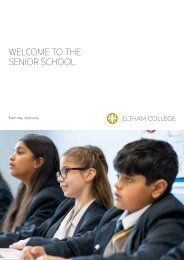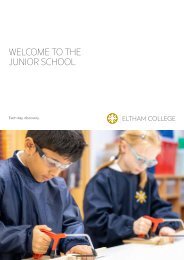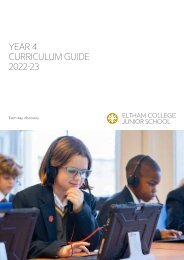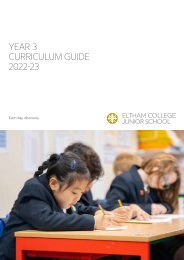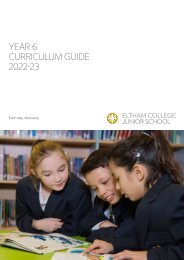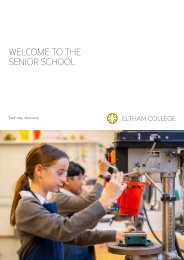JS Curriculum Guide - Year 5 - 2022-23
Create successful ePaper yourself
Turn your PDF publications into a flip-book with our unique Google optimized e-Paper software.
Mathematics<br />
Teaching Arrangement<br />
As in <strong>Year</strong> 4, students will be taught in sets for Maths during <strong>Year</strong><br />
5. Teaching in sets allows for a smaller group size, and for<br />
learning to be more focused to the particular needs of individuals<br />
or groups of students within a set. The sets will be covering the<br />
same topics from the same scheme of work; it may be, however,<br />
that one set spends slightly more or less time on a certain topic,<br />
or approaches the learning from a more practical or abstract<br />
perspective than others, depending on need.<br />
There is a level of fluidity as to which set students are in, and<br />
changes can be made during the year depending on a range of<br />
factors (not purely scores in assessments). Ability levels do<br />
overlap between sets, especially as different children can have<br />
relative strengths in different topics.<br />
Scheme of Work<br />
Mathematics work this year will continue to primarily use content<br />
from the Pearson “Power Maths” scheme, although we<br />
supplement this with other relevant and engaging resources; we<br />
do not follow the Power Maths workbooks lesson-by-lesson. This<br />
approach will give pupils the chance to develop their conceptual<br />
understanding of topics as well as applying them in<br />
problem-solving and structured practice situations. Students will<br />
be expected to have full and deep confidence in the schemes’<br />
<strong>Year</strong> 5 content, with extension through depth of topic application.<br />
Many topics are covered over the course of the year; below you<br />
will find a summary of topics and expectations.<br />
Calculations<br />
Students will meet, revisit, practise and perfect a range of<br />
calculation methods in all four operations (addition, subtraction,<br />
multiplication and division) over the course of the year. These will<br />
include formal written methods, mental approaches and informal<br />
methods, involving jottings, which support the use of mental<br />
methods over time. The key idea is efficiency - students will be<br />
encouraged to reflect on the numbers involved in a calculation<br />
and choose a method which will lead to the solution efficiently<br />
and securely, rather than always using a certain method<br />
whatever the problem.<br />
Mental Maths and Times Tables<br />
Students will receive regular informal mental maths tests –<br />
designed to identify areas for extra practice and development- as<br />
well as check-ups of times table knowledge. It is expected to have<br />
recall of all times table facts to 12x12 and related division facts by<br />
the end of the year, and students should be increasingly able to<br />
recall square and prime numbers under 100 from memory.<br />
Problem-Solving<br />
Much mathematical content is learned or applied through<br />
problem-solving. As such, students will be given opportunities<br />
to use their ‘problem-solving toolkit’ regularly, involving skills<br />
such as:<br />
talk it through; make a list; try a simpler case; trial and<br />
improvement; draw a diagram; find a rule or pattern; use a<br />
system; act it out.<br />
Explicit reference to these strategies within lessons will give<br />
students confidence to identify and use them in their own<br />
independent problem-solving. Students should be learning<br />
to explain and prove mathematical patterns using<br />
appropriate language..








